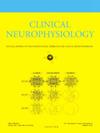帕金森病踝关节本体感觉与僵硬的关系
IF 3.7
3区 医学
Q1 CLINICAL NEUROLOGY
引用次数: 0
摘要
目的本体感觉机械感受器传入是体位感知和肌张力调节的基础。帕金森病(PD)与本体感觉功能障碍有关。本研究旨在探讨PD患者踝关节位置感功能障碍的程度及其与肌张力异常的关系。方法16例PD患者和16例对照组。使用双强迫选择心理物理范式,参与者的脚踝被动地旋转到两个位置-跖屈15°的参考位置和较小幅度的比较位置。随后,用户口头指出哪个位置被认为更容易跖屈。根据刺激-反应数据,导出了可注意差异阈值(JND)和不确定区域(UA)作为踝关节位置感敏锐度的度量。采用MDS-UPDRS III量表评估肌肉僵硬度。结果PD组中位JND阈值和UA均显著高于对照组(p <;0.05)。JND阈值与下肢僵硬度呈正相关(p = 0.047)。结论pd可导致踝关节位置感灵敏度降低。较低的本体感觉敏锐度往往与较高的刚性相关,这表明PD广泛地改变了本体感觉信号处理,影响了肌肉张力的感知和调节。意义本体感觉加工的损伤是PD患者本体感觉功能障碍和僵硬的主要原因。本文章由计算机程序翻译,如有差异,请以英文原文为准。
Ankle proprioception and the relationship to rigidity in Parkinson’s disease
Objective
Proprioceptive mechanoreceptor afferents form the basis for the perception of body position and muscle tone regulation. Parkinson’s disease (PD) is associated with proprioceptive dysfunction. This study aimed to characterize the extent of ankle position sense dysfunction in PD and its relationship with abnormal muscle tone.
Methods
Sixteen people with PD and 16 controls participated. Using a 2-forced-choice psychophysical paradigm, a participant’s ankle was passively rotated to two positions – a reference of 15° plantarflexion and a smaller amplitude comparison position. Subsequently, the user verbally indicated which position was perceived as more plantarflexed. From the stimulus–response data a just-noticeable-difference (JND) threshold and uncertainty area (UA) were derived as measures of ankle position sense acuity. Muscle rigidity was assessed using the MDS-UPDRS III scale.
Results
Both median JND threshold and UA were significantly elevated in the group with PD compared to controls (p < 0.05). JND threshold correlated positively with lower extremity rigidity (p = 0.047).
Conclusion
PD can lead to reduced ankle position sense acuity. Lower proprioceptive acuity tended to be associated with higher rigidity, suggesting that PD broadly alters proprioceptive signal processing affecting both perception and regulation of muscle tone.
Significance
Impairments in proprioceptive processing contribute to both proprioceptive dysfunction and rigidity in PD.
求助全文
通过发布文献求助,成功后即可免费获取论文全文。
去求助
来源期刊

Clinical Neurophysiology
医学-临床神经学
CiteScore
8.70
自引率
6.40%
发文量
932
审稿时长
59 days
期刊介绍:
As of January 1999, The journal Electroencephalography and Clinical Neurophysiology, and its two sections Electromyography and Motor Control and Evoked Potentials have amalgamated to become this journal - Clinical Neurophysiology.
Clinical Neurophysiology is the official journal of the International Federation of Clinical Neurophysiology, the Brazilian Society of Clinical Neurophysiology, the Czech Society of Clinical Neurophysiology, the Italian Clinical Neurophysiology Society and the International Society of Intraoperative Neurophysiology.The journal is dedicated to fostering research and disseminating information on all aspects of both normal and abnormal functioning of the nervous system. The key aim of the publication is to disseminate scholarly reports on the pathophysiology underlying diseases of the central and peripheral nervous system of human patients. Clinical trials that use neurophysiological measures to document change are encouraged, as are manuscripts reporting data on integrated neuroimaging of central nervous function including, but not limited to, functional MRI, MEG, EEG, PET and other neuroimaging modalities.
 求助内容:
求助内容: 应助结果提醒方式:
应助结果提醒方式:


